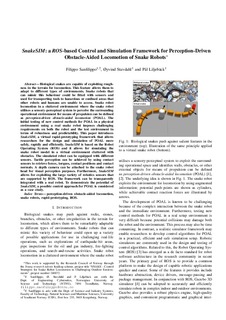| dc.contributor.author | Sanfilippo, Filippo | |
| dc.contributor.author | Stavdahl, Øyvind | |
| dc.contributor.author | Liljebäck, Pål | |
| dc.date.accessioned | 2019-01-25T13:02:18Z | |
| dc.date.available | 2019-01-25T13:02:18Z | |
| dc.date.created | 2018-08-06T11:09:05Z | |
| dc.date.issued | 2018 | |
| dc.identifier.issn | 1433-5298 | |
| dc.identifier.uri | http://hdl.handle.net/11250/2582394 | |
| dc.description.abstract | Biological snakes are capable of exploiting roughness in the terrain for locomotion. This feature allows them to adapt to different types of environments. Snake robots that can mimic this behaviour could be fitted with sensors and used for transporting tools to hazardous or confined areas that other robots and humans are unable to access. Snake robot locomotion in a cluttered environment where the snake robot utilises a sensory–perceptual system to perceive the surrounding operational environment for means of propulsion can be defined as perception-driven obstacle-aided locomotion (POAL). The initial testing of new control methods for POAL in a physical environment using a real snake robot imposes challenging requirements on both the robot and the test environment in terms of robustness and predictability. This paper introduces SnakeSIM, a virtual rapid-prototyping framework that allows researchers for the design and simulation of POAL more safely, rapidly and efficiently. SnakeSIM is based on the robot operating system (ROS) and it allows for simulating the snake robot model in a virtual environment cluttered with obstacles. The simulated robot can be equipped with different sensors. Tactile perception can be achieved using contact sensors to retrieve forces, torques, contact positions and contact normals. A depth camera can be attached to the snake robot head for visual perception purposes. Furthermore, SnakeSIM allows for exploiting the large variety of robotics sensors that are supported by ROS. The framework can be transparently integrated with a real robot. To demonstrate the potential of SnakeSIM, a possible control approach for POAL is considered as a case study. | nb_NO |
| dc.language.iso | eng | nb_NO |
| dc.publisher | Springer Verlag | nb_NO |
| dc.title | SnakeSIM: a ROS‑based Control and Simulation Framework for Perception‑Driven Obstacle‑Aided Locomotion of Snake Robots | nb_NO |
| dc.title.alternative | SnakeSIM: a ROS‑based Control and Simulation Framework for Perception‑Driven Obstacle‑Aided Locomotion of Snake Robots | nb_NO |
| dc.type | Journal article | nb_NO |
| dc.type | Peer reviewed | nb_NO |
| dc.description.version | acceptedVersion | nb_NO |
| dc.source.pagenumber | 449–458 | nb_NO |
| dc.source.volume | 23 | nb_NO |
| dc.source.journal | Artificial Life and Robotics | nb_NO |
| dc.source.issue | 4 | nb_NO |
| dc.identifier.doi | 10.1007/s10015-018-0458-6 | |
| dc.identifier.cristin | 1599869 | |
| dc.description.localcode | This is a post-peer-review, pre-copyedit version of an article published in [Artificial Life and Robotics] Locked until 22.8.2019 due to copyright restrictions. The final authenticated version is available online at: https://doi.org/10.1007/s10015-018-0458-6 | nb_NO |
| cristin.unitcode | 194,63,25,0 | |
| cristin.unitname | Institutt for teknisk kybernetikk | |
| cristin.ispublished | false | |
| cristin.fulltext | postprint | |
| cristin.qualitycode | 1 | |
